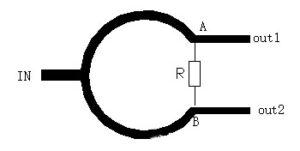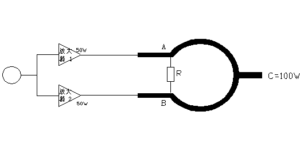The difference lies in the different power. Take the two way power divider as an example.

As a power divider, the signal is input from in. When the signal reaches points a and B, it is the same frequency and phase signal.
Therefore, there is no current flowing on R, that is, no power loss. R plays a role in improving isolation.
The signals are equally distributed to out1 and out2.
At this time, the power capacity mainly depends on the power carried by the microstrip line.
Of course, the selection of R value should also consider the open circuit and short circuit at the out end.
As a combiner, the signals in the above figure are input from out1 and out2 respectively.
Because out1 and out2 are two different signal sources, their frequencies and phases at a and B are different.
At this time, there is current flowing on R. According to theoretical calculation (refer to microstrip circuit design principle), the power carried on R is 1/2out1 + 1/2out2.
If 10W power is input to out1 and out2 respectively, the power resistor of at least 10W shall be selected for R.
Similarly, the power of out1 and out2 reaching “in” can only be 1/2out1 + 1/2out2.
There is a case that in = out1 + out2 can be established.
The following figure is the schematic diagram of a 100W power amplifier.

If there is no phase difference between the tubes of amplifier 1 and amplifier 2, the same excitation signal is amplified.
There is a 50W signal with the same frequency and phase at points a and B.
No power loss on R.
So all the energy is synthesized to the C port.
Because the power divider usually adopts microstrip structure, the value of balance resistance R is generally small.
And the heat dissipation surface is not large enough, so the power divider should not be used for high-power synthesis.
3dB Hybrid Combiner is recommended for the synthesis of two high-power carrier signals.
Since 3dB hybrid can adopt cavity structure and high-power rf external load, it is suitable for high-power signal synthesis.
